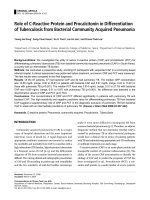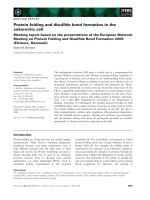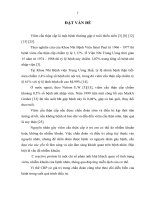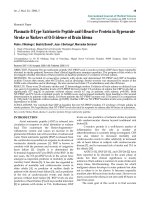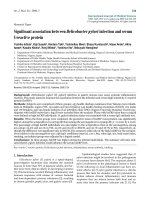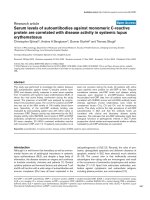Utility of qualitative C- reactive protein assay and white blood cells counts in the diagnosis of neonatal septicaemia at Bugando Medical Centre, Tanzania
Bạn đang xem bản rút gọn của tài liệu. Xem và tải ngay bản đầy đủ của tài liệu tại đây (439.18 KB, 8 trang )
Chacha et al. BMC Pediatrics 2014, 14:248
/>
RESEARCH ARTICLE
Open Access
Utility of qualitative C- reactive protein assay and
white blood cells counts in the diagnosis of
neonatal septicaemia at Bugando Medical Centre,
Tanzania
Flora Chacha1†, Mariam M Mirambo2†, Martha F Mushi2, Neema Kayange1, Antke Zuechner1,
Benson R Kidenya3 and Stephen E Mshana2*
Abstract
Background: Neonatal septicaemia diagnosis based on clinical features alone is non-specific leading to the
initiation of unnecessary antibiotic treatment posing a danger of increased antibiotic resistance. In the present
study the utility of serial qualitative C-reactive protein (CRP) assay and white blood cells count (WBC) in the
diagnosis of neonatal septicaemia was investigated using blood culture as gold standard.
Methods: A total of 305 neonates admitted at Bugando Medical Centre (BMC) neonatal units between September
2013 and April 2014 were enrolled. Demographic and clinical data were collected using standardized data
collection tool. Blood specimens were collected for blood culture, WBC count and qualitative CRP assay.
Results: Of 305 neonates; 224 (73.4%) were ≤ 72 hrs of age and 91(29.8%) had low birth weight. The positive CRP
assay was observed in 67 (22.0%), 80 (26.2%) and 88 (28.9%) of neonates on day 1, 2 and 3 respectively; with any
CRP positive occurred in 104 (34.1%) of neonates. The sensitivities of CRP assay in the diagnosis of septicaemia
using culture as gold standard on day 1, 2, 3 and any positive were 40.4%, 53.2%, 54.8% and 62.9% respectively.
While specificities were 82.7%, 80.7%, 77.8% and 73.3% respectively. Higher sensitivity of 75% was observed when
CRP was used to diagnose gram negative septicaemia compared to 50% that was observed in the diagnosis of
gram positive septicaemia. WBC count of ≥13 × 109 /L had sensitivity and specificity of 64.5% and 66.7%
respectively with area under the curve of 0.694. When the any positive CRP and WBC of ≥13 × 109 /L were used the
sensitivity increased to 90.3% with specificity of 50%. Neonates with septicaemia due to gram negative bacteria
were significantly found to have higher rates of positive CRP than neonates with gram positive septicaemia and
with negative culture (p < 0.001, OR 8.2, 95 CI; 2.9-26).
Conclusion: In place where blood culture is limited neonates having clinical features of neonatal sepsis with
positive qualitative CRP assay and increased WBC should urgently be initiated on appropriate sepsis management
in order to reduce morbidity and mortality associated with neonatal sepsis.
Keywords: C-reactive protein, Neonatal sepsis, WBC
* Correspondence:
†
Equal contributors
2
Department of Microbiology/Immunology Weill Bugando School of
Medicine, Catholic University of Health and Allied Sciences (CUHAS), P.O.
BOX 1464, Mwanza, Tanzania
Full list of author information is available at the end of the article
© 2014 Chacha et al.; licensee BioMed Central Ltd. This is an Open Access article distributed under the terms of the Creative
Commons Attribution License ( which permits unrestricted use, distribution, and
reproduction in any medium, provided the original work is properly credited. The Creative Commons Public Domain
Dedication waiver ( applies to the data made available in this article,
unless otherwise stated.
Chacha et al. BMC Pediatrics 2014, 14:248
/>
Background
Neonatal deaths account for about 40% of all deaths
among underfives. Out of all neonatal deaths in developing countries, 50% occur during the first 24 hours of life
and 75% during the first week of life [1]. Globally, deaths
occurring in the first month of life have increased from
36% in 1990 to 43% in 2011. Most of deaths have been
due to neonatal septicaemia and prematurity [2]. In 2010
at the Bugando medical center (BMC) prevalence of neonatal septicaemia was 39% with mortality rate of 19% [3].
Delayed diagnosis and inappropriate treatment of neonatal
septicaemia has been associated with neurological complication with increased mortality [4].
Though blood culture is the gold standard in the diagnosis of neonatal septicaemia, it takes more than 3 days
for the final results to be available and the technique is
not available in many settings in developing countries [5].
This necessitates the use of antibiotics with no supporting
microbiological results; hence leading to unnecessary cost
and risk of increased resistance development. In developing countries, there are no suitable clinical or laboratory
parameters available to guide the duration of the antibiotic
treatment. At BMC and in many other centres in developing countries, full antibiotics courses are prescribed in all
neonates suspected with septicaemia regardless of culture
results. This practice at BMC does not reduce the mortality due to neonatal septicaemia however it has been found
to add to the problem of antibiotic resistance, as evidenced by the fact that all Klebsiella pneumoniae isolated
in the neonatal unit were resistant to gentamicin and being more than 50% resistant to third generation cephalosporin [6].
Early diagnosis followed by appropriate treatment of all
newborns with clinical suspicion of septicaemia has been
found to be an important strategy in preventing life threatening complications [7]. Most of the time, initial diagnosis
of neonatal septicaemia is based on clinical features which
are non-specific; resulting in initiation of unnecessary empirical antibiotic treatment posing to a danger of increased
antibiotic resistance [8].
Therefore; in order to guide the empiric antibiotic
treatment it is important to evaluate cheap and inexpensive CRP assay as a rapid test to justify the use and
duration of antibiotics treatment in many settings in developing countries. C-reactive protein is an acute-phase
reactant protein synthesized by the liver within six
hours after the onset of infectious process [9,10]. There
is variation in the performance of CRP in the diagnosis
of septicaemia depending on the etiology of septicaemia
and the setting. Therefore this study aimed at evaluating
the use of serial qualitative CRP assay as a rapid test to
accurately predict neonatal septicaemia so as to avoid
unnecessary use of antibiotics and to guide the duration
of antibiotic therapy.
Page 2 of 8
Methods
Study design and study area
This was a hospital based analytical cross sectional study
conducted from October 2013 to April 2014. This study
was conducted at BMC, Mwanza, Tanzania which is a tertiary teaching hospital serving about 14 million population.
Inclusion criteria and exclusion criteria
All neonates with clinical suspicion of neonatal sepsis
according to WHO criteria [11] admitted at NICU and
premature Unit were enrolled. Neonates with history of
use of antibiotics before enrolment for more than 72 hours
and those with body weight less than 1 kilogram were excluded from the study.
Sample size and sampling procedure
Sample size was estimated using Buderer formula [12];
using anticipated sensitivity and specificity of 95% and neonatal sepsis prevalence of 40% [3]. The minimum sample
size obtained was 305 neonates. All neonates admitted to
the neonatal wards with clinical sepsis were recruited serially into the study until the sample size was reached. Using
WHO guidelines for sepsis in young infants a standard
structured data collection tool was designed and used to
obtain social demographic data and other relevant factors
related to neonatal septicaemia like maternal fever, premature rupture of membrane (PROM), mode of delivery, birth
weight of the baby, gestational age (less than 37 completed
weeks was considered as premature), temperature of the infant, respiratory rate, cyanosis, jaundice, umbilical redness,
convulsion, decreased movement and ability to breast feed.
Laboratory procedures
C - reactive protein assay
C-reactive protein was tested qualitatively using Immunopak (RECKON DIAGNOSTICS, INDIA). About 0.3 ml or
0.5 ml of venous blood was collected at 24 hours, 48 hours
and 72 hours after admission using plain bottles (BD
Vacutainer, Nairobi, Kenya). Assays were done following
manufacturer instructions; presence of agglutination similar to positive control was considered as positive CRP
assay indicating CRP level of more than 6 mg/dl.
Blood culture
Blood culture was performed using Brain Heart Infusion
broth (BHI) (Oxoid Ltd) in a ratio of blood to BHI of 1:10
as previously described [3]. Subsequent sub-culture was
done on day 1, 3 and 7 on 5% sheep blood agar, chocolate
agar and MacConkey agar (Oxoid, UK). Identification of
bacteria was performed using conventional physiological
and biochemical methods [13,14]. Repeat blood culture was
ordered in all cases where Coagulase negative staphylococcus (CNS) was isolated. Re-isolation of CNS was considered
significant blood culture result. Antimicrobial susceptibility
Chacha et al. BMC Pediatrics 2014, 14:248
/>
of isolates was determined using disk diffusion method according to the Clinical Laboratory standard Institute (CLSI)
[15].
Complete blood count
About 2 ml of blood in EDTA container (BD Vacutainer,
Nairobi, Kenya) was collected for WBC count and platelet count and estimated using hematological analyzer
(Beckman coulter (UK) LTD). WBC count of less than
9 × 109/l or more than 30 × 109/l were considered as
leucopenia and leukocytosis respectively [16].
Page 3 of 8
neonates with clinical suspicion of sepsis, 305 (98%) were
enrolled in the study from September 2013 to April 2014.
Of 305 neonates, 224(73.4%) were ≤72 hours of age
(Table 1). Median age was 1 day with IQR of 1–4 days.
Among 305 neonates; 149(48.9%) were male and 156
(51.2%) were female. A total of 69 (22.6%) neonates were
premature. Regarding place of delivery, 30(9.8%) of neonates were delivered at home (Table 1). Thirty one (10.2%)
of the neonates had history of convulsions, 59(19.3%) had
Table 1 Distribution of demographic characteristics of
neonates with sepsis
Data analysis
Child’s characteristic
Data were double entered into Microsoft excel and analyzed using STATA version 11. Results were summarized
using proportions (%) for categorical data and means (SD)
or medians (IQR) for continuous variables. Categorical
variables were compared using either Pearson’s Chi–
squared or Fisher’s exact test where appropriate. The
continuous variables were compared using student t-test
and Wilcoxon sign rank test for parametric and nonparametric variables respectively. To determine the sensitivity and specificity of the CRP in the diagnosing neonatal
septicaemia we used 2-by-2 contingency tables. We used
Receiver operating characteristic (ROC) to determine the
performance WBC in the diagnosis of neonatal septicemia. While, to determine predictors of positive CRP,
univariate followed by multivariate logistic regressions
analysis were performed. Predictors investigated included;
socio-demographic factors, clinical features and laboratory
parameters. Odds ratios with respective 95% confidence
interval (CI) were reported. Predictors with a p-value of
less than 0.05 were considered statistically significant.
Sex
Quality control
Data from questionnaires were entered into a data sheet.
The reading of CRP test was done by two qualified laboratory technologists to avoid bias. All microbiological testing
were controlled using quality control strains; Escherichia
coli ATCC 25922, Klebsiella pneumoniae ATCC 13883
and Staphylococcus aureus ATCC 25923.
Ethical considerations
The proposal of this study was presented to the CUHASBugando/BMC department of Pediatric and Child Health
for approval and then to CUHAS-Bugando ethics committee for clearance. Written Informed consent for the
participation in the study was obtained from mother/caretaker of the respective neonate.
Number
Percent (%)
Female
149
48.9
Male
156
51.2
≤ 72 hours
224
73.4
> 72 hours
81
26.6
Caesarean section
67
22
Spontaneous vertex delivery
238
78
Very low birth weight
18
5.9
Low birth weight
73
23.9
Normal birth weight
214
70.2
Premature
69
22.6
Full term
236
77.4
Age
Mode of delivery
Birth weight
Gestation age
Hospital delivery
Yes
275
90.2
No
30
9.8
Yes
31
10.2
No
274
89.8
Convulsion
Jaundice
Yes
59
19.3
NO
249
80.7
Yes
182
59
No
123
40.3
<90%
133
43.6
>90%
172
56.4
96
31.5
Poor feeding
Oxygen saturation
Body temperature
Results
Baseline characteristics of patient enrolled in the study
During the study period a total of 624 neonates were admitted at NICU and premature neonatal unit. Out of 310
Hypothermia
Normal
23
7.5
Hyperthermia
186
61.0
Chacha et al. BMC Pediatrics 2014, 14:248
/>
Page 4 of 8
jaundice, 186(61%) had body temperature of more than
37.5°C and 133(43.6%) had oxygen saturation of less than
90%.
C-reactive protein and blood culture results
Out of 305 neonates; 104(34.1%) had any positive CRP;
the positive CRP on day 1, 2 and 3 were 67(22%) 80
(26.2%) and 88(28.9%) respectively. Positive aerobic blood
culture was detected in 62(20.3%) of neonates (Table 2).
All specimens with positive culture were detected within
48 hrs of incubation.
Sensitivity, specificity, PPV and NPV of qualitative
CRP assay and WBC
The sensitivity of CRP was found to be 40.4%, 53.2% and
54.8% on day 1, 2 and 3 with specificity of 82.7%, 80.7%
and 77.8% respectively. While the positive predictive value
was found to be 37.5%, 41.3% and 38.6% with negative
predictive value of 84.5%, 87.1%, and 88.6% on day 1, 2
and 3 respectively. Any positive CRP had sensitivity of
62.9% with specificity of 73.3% (Table 2). Higher sensitivity
was obtained when CRP was used to diagnose gram negative septicaemia than in the diagnosis of gram positive
septicaemia (75% vs. 50%) with the same specificity. Using
WBC cut off point of ≥13 × 109 /L the sensitivity obtained
was of 64.5% with specificity of 66.7% and area under the
curve of 0.6924 (Figure 1). When any positive CRP was
combined with raised WBC of ≥13 × 109 /L the sensitivity
and specificity obtained were 90.3% and 50.2% respectively
(Table 2).
C-reactive protein, WBC and neonatal sepsis
Higher rates of CRP positive were observed among neonates with confirmed neonatal sepsis than those with
negative culture (p <0.05) Figure 2. Neonates with gram
negative sepsis had significantly higher rates of positive
CRP than neonates with gram positive neonatal sepsis
and neonates with negative blood culture. Significantly
higher means of WBC were observed among neonates
with positive blood culture and those with positive CRP
when compared to neonates with negative culture and
negative CRP. Means WBC among neonates with gram
negative septicaemia and gram positive septicaemia were
20431.25c/mm3 and 20525.26 c/mm3 respectively compared to the mean of 13915.72/mm3 among children
with negative blood culture (Table 3).
Predictors of positive CRP and neonatal septicaemia
On univariate analysis; the predictors of positive CRP
were found to be older age (p = 0.03) and higher body
temperature (p = 0.02), however on multivariate analysis
only poor feeding and raised body temperature remained
significantly associated with positive CRP (Table 4). Factors found to predict neonatal septicaemia were positive
CRP (p < 0.001, 95% CI; 2.6-8.2), elevated WBC (p <
0.001, 95% CI; 1.03-1.08), high body temperature (p =
0.04, CI 1.01-1.32) and home delivery 95% CI; 2.29(1.055.01). Of 305 neonates, 22(7.2%) died during the study
period. Meconium aspiration (OR 3.3, 95% CI (1.1-10.5),
p = 0.038), convulsions (OR 5.4, 95% CI (1.8-16.2), p =
0.003), oxygen desaturation <90% (OR 4.7(CI 1.3-16.8)
p = 0.017) and jaundice (OR 7.8(CI 2.3-26.9) p = 0.001
were independent factors found to be associated with
death. Neonates with positive CRP had 1.7 times risk of
death than those with negative CRP.
Discussion
Baseline characteristics
The study involved 305 neonates with suspected neonatal septicaemia attending BMC neonatal units. As in
previous studies [3,17,18], most of these neonates were
below 72 hrs of age and with low birth weight. The low
birth weight in the current study is partially contributed
to premature delivery because 22.6% of neonates were
delivered prematurely of whom 29.5% had low birth
weight. In contrast to previous study which observed
home delivery in 38% of neonates with suspected neonatal sepsis in the current study only 9.8% of neonates
were delivered at home. From 2010 to 2012, we observed a decrease in home delivery of more than 70%;
this could be due to ongoing campaigns by NGOs and
Table 2 Sensitivity, Specificity, Positive and negative predictive values
Parameters
Sensitivity
Specificity
PPV
NPV
Any CRP + ve
62.9% (49.7-74.8)
73.3% (67.2-78.7)
37.5% (28.2-47.5)
88.6% (83.3-92.6)
CRP day 1
40.3% (28.1-53.6)
82.7% (77.4-87.3)
37.5% (25.8-50.0)
84.5% (79.2-88.8)
CRP day 2
53.2% (40.1-66.0)
80.7% (75.1-85.4)
41.3% (30.4-52.8)
87.1% (82.0-91.2)
CRP day 3
54.8% (41.7-67.5)
77.8% (72.0-82.8)
38.6% (28.4-49.6)
87.1% (81.9-91.3)
WBC
64.5% (51.3-76.3)
66.7% (60.4-72.6)
33.1 (24.8-42.2)
88.4 (82.5-92.4)
Any CRP + WBC
90.3% (80.1-96.4)
50.2% (43.7-56.7)
31.6% (24.9-39.0)
95.3% (90.1-98.3)
CRP gram negative sepsis
75.0% (53.3-90.2)
73.3% (67.8-78.7)
21.7% (13.4-32.1)
96.7% (93.0-98.8)
CRP gram positive sepsis
55.3% (38.3-71.4)
73.2% (67.2-78.7)
24.4% (15.8-34.9)
91.3% (86.4-94.8)
Chacha et al. BMC Pediatrics 2014, 14:248
/>
Page 5 of 8
Figure 1 Receiver operating characteristic (ROC) of WBC and blood culture showing the performance WBC in the diagnosis of
neonatal septicemia. Cut off points of WBC ≥ 13* 109 /L has sensitivity of 64.5% and specificity 66.7%.
Ministry of Health Tanzania resulting in awareness of
health services and importance of hospital delivery.
Clinical presentation of neonates
Clinical features of neonatal sepsis are usually non-specific
and subtle and neonates with suspected sepsis can present
with one or more of the following; fever, jaundice, convulsion, lethargy, poor feeding etc. Almost similar rates
clinical findings (poor feeding, cyanosis, jaundice, body
temperature, lethargy, chest in drawing) were observed in
this study as in other studies in Tanzania [3,18]. This
could be explained by the fact that similar inclusion
criteria were used to enroll study participants. Compare to
previous study in the same setting 4 years ago, low convulsion rate was observed in the present study, this could be
60
54.8
Percent of CRP positivity
53.2
40.3
40
22.2
20
0
19.3
17.3
Day 1
Day 2
Negative blood culture
Day 3
Positive blood culture
Figure 2 Bar charts showing the rates of positive CRP among
culture positive and culture negative neonates on day 1, 2
and 3.
due to less birth asphyxia in present study since most neonates were hospital delivery and also there are improvements in NICU care especially in checking random blood
glucose to prevent hypoglycemia.
Utility of qualitative CRP assay and WBC count in the
diagnosis of neonatal septicaemia
In the present study, the overall sensitivity and specificity
of CRP in the diagnosis of neonatal septicaemia were 63%
and 73% respectively. Almost similar findings were observed in Nigeria whereby sensitivity and specificity of
74% and 74.1% respectively were observed using semiquantitative assay [19]. The slightly difference could be explained by the type of the tests used, in Nigeria study they
used Lorne CRP latex kit from Great Britain while in the
current study the semi-quantitative assay from Reckon
Diagnostic, India, Immunopak was used. Low sensitivity
and specificity are observed when our results are compared with other studies [10,20,21] which used quantitative assays.
There are no established references intervals of CRP in
the neonatal period and upper limit have been established
only in symptomatic neonates. CRP may rise physiologically after stressful delivery, intraventricular hemorrhage,
fetal distress, perinatal asphyxia and meconium aspiration.
In these conditions the CRP level usually goes back to
normal within 24–48 hours. These conditions contribute
to the reduced specificity of the qualitative assay of CRP
in the diagnosis of neonatal septicaemia. In these situations, a single normal value is not sufficient to diagnose
neonatal septicaemia, therefore to increase specificity serial assays are recommended. In most of the time neonates
with persistent high CRP levels are more likely to have
Chacha et al. BMC Pediatrics 2014, 14:248
/>
Page 6 of 8
Table 3 CRP, Neonatal sepsis and WBC in relation to gram reactions
CRP
% CRP positive
OR
95% CI
P value
Negative culture (243)
42 (17.3%)
1
Gram positive sepsis (38)
12 (31.5%)
2.2
0.93-4.9
0.0375
Gram negative sepsis (24)
13 (54.4%)
5.6
2.1-14.87
<0.0001
Negative culture (243)
47 (19.3%)
1
Gram positive sepsis (38)
17 (44.7%)
3.4
1.5-7.2
0.0005
Gram negative sepsis (24)
16 (66.7%)
8.3
3.1-23.67
<0.0001
Negative culture (243)
54 (22.2%)
1
Gram positive sepsis (38)
17 (44.7%)
2.8
1.2-6.0
0.003
Gram negative sepsis (24)
17 (70.0%)
8.5
3.1-25.3
<0.0001
Negative culture (243)
65 (26.7%)
1
Gram positive sepsis (38)
21 (55.2%)
3.3
1.5-7.2
0.0004
<0.0001
CRP1
CRP2
CRP3
Any positive
Gram negative sepsis (24)
Parameter
18 (75.0%)
8.2
2.9-26.2
N
Mean WBC c/mm3
P value
Negative culture
243
13915.72 ± 11707.4
Gram positive sepsis
38
20525.26 ± 11800.8
0.0007
Gram negative sepsis
24
20431.25 ± 14107.8
0.0056
Positive
67
18025.1 ± 15964.6
Negative
238
14471.2 ± 10782.2
Positive
80
16785.6 ± 13529.9
Negative
225
14706.6 ± 11633.8
Positive
88
16925.8 ± 12697.2
Negative
217
14573.1 ± 11914.3
Positive
104
17301.7 ± 14137.8
Negative
201
14191.3 ± 10865.0
CRP positive
CRP1
0.0173
CRP2
0.0950
CRP3
0.0632
Any CRP positive
neonatal sepsis. In the present study there was an increase
in positive rates of CRP among neonates from day 1 to
day 3 with majority of neonates who were positive on day
1 remained positive on day 3. These findings suggest that
most of our neonates with positive CRP had septicaemia
[22]. The discrepancy between CRP and culture results in
this study could be explained by the culture technique
used. In the present study manual blood culture was used;
this technique has been found to contribute to low sensitivity of CRP when compared to automated techniques
[23]. However, there has been wide range of CRP sensitivity reported ranging from 47-100% and this is due to
0.0086
different reference values and test methodologies [23].
Using quantitative methods; CRP assays have been shown
to have higher sensitivity than qualitative methods. Other
factors that could explain low sensitivity in our study is
the predominant of gram positive bacteria; neonates with
gram positive septicaemia were found to have significantly
lower rates of positive CRP than among neonates with
gram negative sepsis. Several studies have reported Creactive protein to be higher in gram negative bacteria
than gram positive bacteria neonatal septicaemia [24,25].
In this study when sub-analysis was done the sensitivity of
CRP to diagnose gram negative neonatal septicaemia
Chacha et al. BMC Pediatrics 2014, 14:248
/>
Page 7 of 8
Table 4 Factors associated with positive CRP, neonatal sepsis and death on multivariate logistic regression
CRP
Age in days
Neonatal sepsis
P value
OR [95% CI]
P value
OR [95% CI]
P value
1.05 (1.00-1.11)
0.034
1.1 (1.0-1.1)
0.056
-
-
1.84 (1.1-3.188)
0.029
Home delivery
Poor feeding
Deaths
OR [95% CI]
2.29 (1.05-5.01)
0.045
-
-
-
-
-
-
Body temperature
1.18 (1.03-1.35)
0.016
1.15 (1.01-132)
0.038
-
-
WBC
1.02 (1.00-1.040)
0.05
1.06 (1.03-1.08)
<0.001
-
-
CRP positive
-
-
4.6 (2.6-8.2)
<0.001
1.7 (0.6-4.8)
0.352
Convulsion
-
-
-
-
5.49 (1.8-16.2)
0.003
Meconium liquor
-
-
-
-
3.3 (1.1-10.5)
0.038
Jaundice
-
-
-
-
7.8 (2.3-26.9)
0.001
O2 saturation < 90%
-
-
-
-
4.7 (1.3-16.8)
0.017
increased to 75% while for gram positive septicaemia
dropped to 50%.
In several previous studies [26-28]; WBC shows little
correlation with neonatal septicaemia however in the
present study neonates with septicaemia had significantly
higher mean of WBC than those with negative culture.
The sensitivity of increased WBC of ≥13 × 109/L in the
diagnosis of neonatal septicaemia was comparable to previous studies. When the increased WBC was combined
with any positive CRP sensitivity of 90.3% was obtained
similar to a recent study among preterm babies [29].
Including neonates admitted at Bugando Medical
Center with clinical suspicion of neonatal sepsis was
major limitation of this study. Other limitations include
lack of lumbar puncture due to lack of appropriate instruments and/or supplies. Additionally the blood culture was
done using only the aerobic manual system again because
of lack of equipment and supplies. Finally, there was no
control group due to ethical constraints and difficulty
obtaining blood in infants who have no clinical suspicious
for septicaemia.
Conclusion
Serial CRP qualitative assays combined with raised WBC
has high sensitivity in the diagnosis of neonatal septicaemia. In place where blood culture is limited, neonates with
positive qualitative CRP assay and raised WBC together
with clinical features such as convulsion, raised body
temperature and poor feeding should urgently be initiated
on appropriate sepsis management in order to reduce
associated morbidity and mortality. Based on these findings CRP and WBC counts can be used as inexpensive
methods to diagnose neonatal septicaemia in developing
countries in order reduce the duration of antibiotics treatment hence preventing resistance development. Another
study using quantitative CRP assay should be considered
in our setting in order to estimate the cutoff point of CRP
which strongly predicts neonatal septicaemia.
Competing interest
The authors declare that they have no competing interests.
Authors’ contributions
FC, NK, MMM and SEM designed the study. FC, NK, AZ enrolled the patients
and collected the samples. FC, BRK, MFM and SEM analyzed the data. FC,
MMM and SEM wrote the manuscript which was revised and approved by
all co authors.
Acknowledgements
We are very gratefully for the parents who allow their neonates to
participate in the study. We would like to acknowledge the assistance and
guidance provided by all staff members of the Department of Pediatrics,
Bugando Medical Center, as well as the Department of Microbiology/
Immunology, Catholic University of Health and Allied Sciences, Bugando
Hospital. This research was supported by grants from Ministry of Health to
FC, reagents from CUHAS to SEM.
Author details
1
Department of Pediatric and child Health Weill Bugando School of
Medicine, Mwanza, Tanzania. 2Department of Microbiology/Immunology
Weill Bugando School of Medicine, Catholic University of Health and Allied
Sciences (CUHAS), P.O. BOX 1464, Mwanza, Tanzania. 3Department of
Biochemistry and Molecular Biology, Weill Bugando School of Medicine,
Mwanza, Tanzania.
Received: 4 August 2014 Accepted: 29 September 2014
Published: 3 October 2014
References
1. Vergnano S, Sharland M, Kazembe P, Mwansambo C, Heath P: Neonatal
sepsis: an international perspective. Arch Dis Child Fetal Neonatal Ed 2005,
90(3):F220–FF224.
2. Blencowe H, Cousens S: Review: addressing the challenge of neonatal
mortality. Trop Med Int Health 2013, 18(3):303–312.
3. Kayange N, Kamugisha E, Mwizamholya DL, Jeremiah S, Mshana SE:
Predictors of positive blood culture and deaths among neonates with
suspected neonatal sepsis in a tertiary hospital, Mwanza-Tanzania.
BMC Pediatr 2010, 10(1):39.
4. Lim DV, Morales W, Walsh A, Kazanis D: Reduction of morbidity and
mortality rates for neonatal group B streptococcal disease through early
diagnosis and chemoprophylaxis. J Clin Microbiol 1986, 23(3):489–492.
5. Paes BA, Modi A: Value of superficial cultures: diagnosing neonatal sepsis
in a community hospital. Can Fam Physician 1992, 38:1796–1800.
6. Mshana SE, Hain T, Domann E, Lyamuya EF, Chakraborty T, Imirzalioglu C:
Predominance of klebsiella pneumoniae ST14 carrying CTX-M-15 causing
neonatal sepsis in Tanzania. BMC Infect Dis 2013, 13:466.
7. Volante E, Moretti S, Pisani F, Bevilacqua G: Early diagnosis of bacterial
infection in the neonate. J Matern Fetal Neonatal Med 2004, 16(2):13–16.
Chacha et al. BMC Pediatrics 2014, 14:248
/>
8.
9.
10.
11.
12.
13.
14.
15.
16.
17.
18.
19.
20.
21.
22.
23.
24.
25.
26.
27.
28.
29.
Thaver D, Zaidi AK: Burden of neonatal infections in developing
countries: a review of evidence from community-based studies.
Pediatr Infect Dis J 2009, 28(1):S3–S9.
Chiesa C, Panero A, Osborn JF, Simonetti AF, Pacifico L: Diagnosis of neonatal
sepsis: a clinical and laboratory challenge. Clin Chem 2004, 50(2):279–287.
Hofer N, Zacharias E, Mueller W, Resch B: An update on the use of Creactive protein in early-onset neonatal sepsis: current insights and new
tasks. Neonatology 2012, 102(1):25–36.
Group WYIS: Clinical prediction of serious bacterial infections in young
infants in developing countries. Pediatr Infect Dis J 1999, 18(10):S23–S31.
Buderer NMF: Statistical methodology: I. Incorporating the prevalence of
disease into the sample size calculation for sensitivity and specificity.
Acad Emerg Med 1996, 3(9):895–900.
Christopher A, Mshana SE, Kidenya BR, Hokororo A, Morona D: Bacteremia
and resistant gram-negative pathogens among under-fives in Tanzania.
Ital J Pediatr 2013, 39(1):27.
Mshana S, Kamugisha E, Miramb M, Chalya P, Rambau P, Mahalu W,
Lyamuya E: Prevalence of clindamycin inducible resistance among
methicillin-resistant staphylococcus aureus at Bugando Medical Centre,
Mwanza, Tanzania. Tanzan J Health Res 2009, 11(2):59–64.
Wikler MA, Cockerill FR, Clinical and Laboratory Standards Institute:
Performance Standards for Antimicrobial Susceptibility Testing: Eighteenth
Informational Supplement. Wayne: Clinical and Laboratory Standards
Institute; 2008.
Bhandari V, Wang C, Rinder C, Rinder H: Hematologic profile of sepsis in neonates:
neutrophil CD64 as a diagnostic marker. Pediatrics 2008, 121(1):129–134.
Mugalu J, Nakakeeto MK, Kiguli S, Kaddu-Mulindwa DH: Aetiology, risk factors
and immediate outcome of bacteriologically confirmed neonatal
septicaemia in Mulago Hospital, Uganda. Afr Health Sci 2006, 6(2):120–126.
Mhada TV, Fredrick F, Matee MI, Massawe A: Neonatal sepsis at Muhimbili
national hospital, Dar es salaam, Tanzania; aetiology, antimicrobial
sensitivity pattern and clinical outcome. BMC Public Health 2012, 12(1):904.
West BA, Peterside O, Ugwu RO, Eneh AU: Prospective evaluation of the
usefulness of C-reactive protein in the diagnosis of neonatal sepsis in a
sub-Saharan African region. Antimicrob Resist Infect Control 2012, 1(1):22.
Nuntnarumit P, Pinkaew O, Kitiwanwanich S: Predictive values of serial C-reactive
protein in neonatal sepsis. J Med Assoc Thai 2002, 85(Suppl 4):S1151–1158.
Khassawneh M, Hayajneh WA, Kofahi H, Khader Y, Amarin Z, Daoud A:
Diagnostic markers for neonatal sepsis: comparing C-reactive protein,
interleukin-6 and immunoglobulin M. Scand J Immunol 2007, 65(2):171–175.
Polin RA: Management of neonates with suspected or proven early-onset
bacterial sepsis. Pediatrics 2012, 129(5):1006–1015.
Malik A, Hui CP, Pennie RA, Kirpalani H: Beyond the complete blood cell
count and C-reactive protein: a systematic review of modern diagnostic
tests for neonatal sepsis. Arch Pediatr Adolesc Med 2003, 157(6):511–516.
Alexandraki I, Palacio C: Gram-negative versus gram-positive bacteremia:
what is more alarming. Crit Care 2010, 14:161.
Vallance H, Lockitch G: Rapid, semi-quantitative assay of C-reactive
protein evaluated. Clin Chem 1991, 37(11):1981–1982.
Franz AR, Kron M, Pohlandt F, Steinbach G: Comparison of procalcitonin
with interleukin 8, C-reactive protein and differential white blood cell
count for the early diagnosis of bacterial infections in newborn infants.
Pediatr Infect Dis J 1999, 18(8):666–671.
Ohlsson A, Vearncombe M: Congenital and nosocomial sepsis in infants
born in a regional perinatal unit: cause, outcome, and white blood cell
response. Am J Obstet Gynecol 1987, 156(2):407–413.
Yoon BH, Jun JK, Park KH, Syn HC, Gomez R, Romero R: Serum C-reactive
protein, white blood cell count, and amniotic fluid white blood cell
count in women with preterm premature rupture of membranes.
Obstet Gynecol 1996, 88(6):1034–1040.
Du J, Li L, Dou Y, Li P, Chen R, Liu H: Diagnostic utility of neutrophil CD64
as a marker for early-onset sepsis in preterm neonates. PLoS One 2014,
9(7):e102647.
doi:10.1186/1471-2431-14-248
Cite this article as: Chacha et al.: Utility of qualitative C- reactive protein
assay and white blood cells counts in the diagnosis of neonatal
septicaemia at Bugando Medical Centre, Tanzania. BMC Pediatrics
2014 14:248.
Page 8 of 8
Submit your next manuscript to BioMed Central
and take full advantage of:
• Convenient online submission
• Thorough peer review
• No space constraints or color figure charges
• Immediate publication on acceptance
• Inclusion in PubMed, CAS, Scopus and Google Scholar
• Research which is freely available for redistribution
Submit your manuscript at
www.biomedcentral.com/submit

